Apple's 2010 MacBook Air (11 & 13 inch) Thoroughly Reviewed
by Anand Lal Shimpi on October 26, 2010 10:08 PM EST- Posted in
- Mac
- Apple
- MacBook Air
- Laptops
The 13
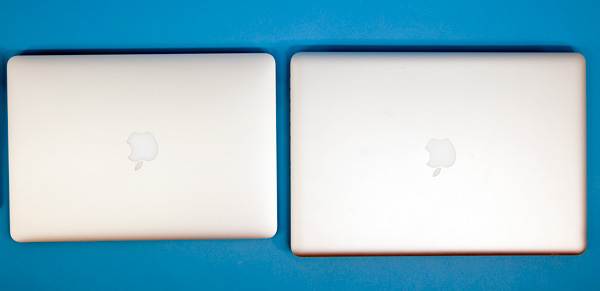
13-inch MacBook Air (left) vs. 15-inch MacBook Pro (right)
The 13-inch MacBook Air feels more like a regular notebook. It’s like one of those cartoons where you see the character straight on and he looks normal sized, but turn him 90 degrees and he’s pencil thin. When viewed from above you’d think you had a 13-inch MacBook Pro on your desktop. Its footprint isn’t that different:

But pick it up and you’re dealing with a much thinner notebook. Like the 11-inch MBA, the 13-inch model ranges from 0.11 inches to 0.68 inches in thickness. You get the same angular ID from the 11-inch model, just on a bigger scale.

13-inch MacBook Air (left) vs. 15-inch MacBook Pro (right)
The underlying hardware is unchanged, although you do get a noticeably quicker CPU. While the 11-inch model ships with a 1.4GHz Core 2 Duo (3MB L2 cache, 800MHz FSB), the 13-inch model comes with a 1.86GHz part by default (6MB L2 cache, 1066MHz FSB). I call it a noticeably quicker CPU because it is noticeably quicker, even in typical day to day use.
The 13.3-inch diagonal screen features a 1440 x 900 display (16:10 ratio). That’s the same screen resolution as the 15-inch MacBook Pro but in a smaller package. And it really makes a big difference when it comes to getting work done on the MacBook Air. This is a big improvement over the limited 1280 x 800 found in the previous two MacBook Airs and a high enough resolution to actually get work done on.
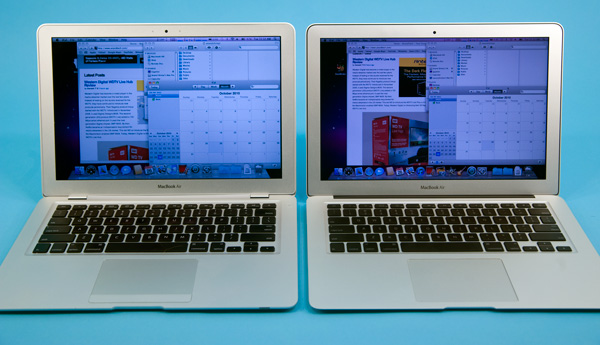
The old 13-inch MacBook Air (left) vs. the new 13-inch MacBook Air (right)
I’d go as far as to say that Apple could’ve bumped pixel density even further and the 13-inch MacBook Air would still be useable.
The 13-inch screen is a bit brighter and has a slightly better contrast ratio than the 11-inch, but it’s not something you’ll notice in use. The same vertical viewing angle limitations apply here. Unlike the 11-inch model however, you’re more likely to notice them because of the size of the display. On a plane when the passenger in front of you leans back all the way you’re probably going to have to angle the 13-inch display, while the 11-inch model may give you enough room to clear.
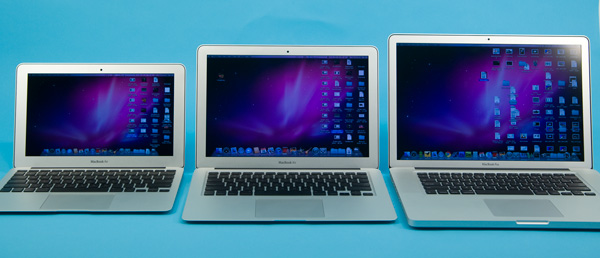
From left to right: 11-inch MBA, 13-inch MBA, 15-inch MBP
The trackpad on the 13-inch model is a taller rectangle, identical in size to what you’d find on a MacBook Pro. The wrist rest area is also normal-sized. In fact, other than the thickness there’s very little that separates the 13-inch MacBook Air from a 13-inch MacBook Pro.
Apple integrated an SD card reader with the 13-inch MBA which further identifies its light workhorse nature. It’s a nice addition that does make the MacBook Air more useful if you have a camera that uses SD cards (*grumbles at the D700*). The rest of the ports are unfortunately just as limited as the 11-inch model, but if you really want an Ethernet port you can either go the USB route or you can get a MacBook.
The stereo speakers are an improvement over the original MacBook Air. The old mono speaker was horrible to listen to. Now you've got two of them, which somehow makes the sound better. This isn’t exactly a set of Klipsch drivers but you get far less of a laughable sound out of them than before
The keyboard is identically sized to the 11-inch. You get larger function keys but there’s still no backlight. The backlit keyboard continues to be the biggest miss from the old MacBook Air.
Apple calls the new MacBook Air the future of the MacBook. If we take that literally it could mean that all future MacBooks will be the Air. Pro users will simply buy the bigger machines if they need the added performance, but the majority of users could get by with the Air. I tend to agree with this philosophy. There’s really no reason to get the base MacBook. The 13-inch MBA sacrifices a bit of performance and expansion, but you get a far more portable machine. For users who need the performance, there's always the Pro line.


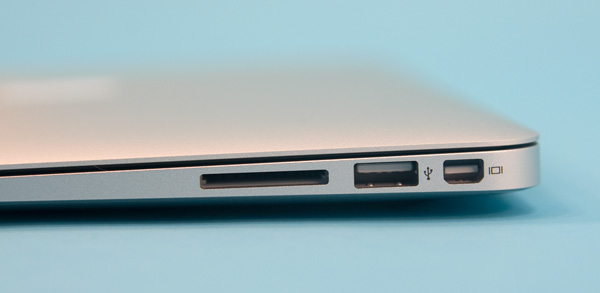
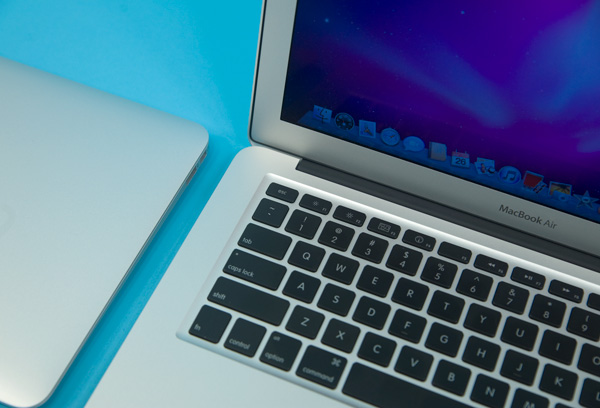








185 Comments
View All Comments
deslock - Thursday, October 28, 2010 - link
Thanks Anand & Vivek for the detailed and interesting review. I hope you post a followup with more info on how Apple was able to get this level of performance out of the hardware (vs other similar SSD-equipped machines). Also I'd like to see a long term test of performance (because of the lack of TRIM), or perhaps additional testing showing just how effective the new MBAs are with GC.Oscarcharliezulu - Thursday, October 28, 2010 - link
Thanks for a great, detailed review that doesn't gloss over any point. I've read as many reviews as I can find and many gloss over or just take things as a given - not much more useful than the Apple web site. Your review was detailed in all the right areas. I know where I will be disappointed and where I will be happy. No surprises thanks to your review.I think for a business user (web + mail + Word processing + presentations + lightweight spreadsheet) the Air's may be pretty good - finally great battery life (with wifi active) so I can go out to a customer and work off battery all day without carrying an extra battery or carrying the AC adapter.
Pity about the price - once you tick the options the price becomes ridiculous when you compare to mainstream laptops. I will have to stick to a base model + 4GB ram, and wait to upgrade the SSD later (someone is sure to come up with an upgrade).
And graphics - for ultraportables its good, but the higher end pro's etc really need a lot more grunt - we should be able to play games at High at native resolution.
pmeinl - Friday, October 29, 2010 - link
Just stumbled across an SSD 256GB upgrade kit for the 11.6":http://www.photofast.tw/products/GM2_SFV1_Air.html
It includes an USB adapter for using the orginal SSD as portable storage.
mutatio - Friday, October 29, 2010 - link
Anyone else hear this thing screaming for Fusion in it? If AMD can finally get their power specs in line to be competitive with intel the 11" would be one smoking little monster if Apple bites at it. :-)63jax - Friday, October 29, 2010 - link
don't hurry to change your mac's, just wait for AMD to release their Fuzion chips and then we will have the perfect Mac's. i know i will...Norrah - Saturday, October 30, 2010 - link
I would really like to see how an older Macbook Air (rev c) with an aftermarket SSD would hold up against the new.. performance wise!I need the last kick, if i am to go for the new.
jorjitop - Saturday, October 30, 2010 - link
I think that there is another factor you missed which makes a difference to the relative performances. That is, the 11 inch has a 800 Mhz front bus, while the 13 inch has a 1066 Mhz front bus. In my experience, this makes a noticeable difference to performance.Brooklynzoned - Saturday, October 30, 2010 - link
Both models are 2010, Both machines are running Window's 7. Both Machines Score a 5.3 out of 7Apple Macbook Pro with a 2.4 8G Ram with a Seagate XT Hybrid....Scored 5.3
Apple Macbook Air with a 2.13 4G Ram with the 256 SSD Flash......Scored 5.3
Dell Adamo Onyx With a 1.4 4G Ram with a 128SSD .....................Scored 3.2
Funny thing is the Macbook Pro has a video card with 256 dedicated memory
the macbook air has shared video memory.... and scored higher in the 3D
Brooklynzoned - Saturday, October 30, 2010 - link
Battery Life Amazing,Speed,, Oh Yeah this baby moves.... N quick.. Faster then my Macbook Pro
its crazy how fast it starts up... not from sleep but from a full shutdown and startup. Fast...
The Macbook Air is The future of what a Notebook Should be.
ioannis - Sunday, October 31, 2010 - link
Anand,on page "The 13", the captions at the top seem to suggest that you are comparing the 13" MBA with 15" MBP, while the text suggests otherwise (13" MBA vs 13" MBP, which makes more sense).
thanks